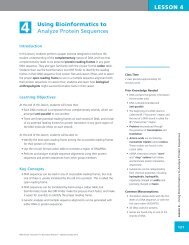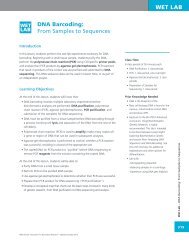2011 Annual Report - Northwest Association for Biomedical Research
2011 Annual Report - Northwest Association for Biomedical Research
2011 Annual Report - Northwest Association for Biomedical Research
- No tags were found...
You also want an ePaper? Increase the reach of your titles
YUMPU automatically turns print PDFs into web optimized ePapers that Google loves.
Bioin<strong>for</strong>matics Program Summary“I didn’t know how topass on science careerinfo be<strong>for</strong>e but have aplat<strong>for</strong>m to teach it nowthrough this curriculum.I feel more confident inbeing able to advocate<strong>for</strong> students to pursue ascience career.”Bio-ITEST TeacherNow in its third and final year, our NSF-funded bioin<strong>for</strong>matics education program Bio-ITEST: New Frontiersin Bioin<strong>for</strong>matics and Computational Biology provided secondary science teachers with rigorous and up-todatecurricular resources and support, reaching 200 new teachers from around the country through ourprofessional development workshops and regional and national education conferences. NWABR connectedteachers with scientists from our partner and member institutions like Novo Nordisk and the Institute <strong>for</strong>Systems Biology in order to provide unique opportunities <strong>for</strong> teachers to dialogue with scientists; <strong>for</strong> manyteachers, this may be their only opportunity to interact directly with scientists, and bring those experiencesback to their students. This program has had an impact on how teachers communicate with each otherand with their students: teachers have grown their community of practice, dialogue with each other atannual reunions and participate in our online community, and inspire their students to pursue sciencerelatedcareers. The Bio-ITEST research study demonstrated sustained gains among teachers throughoutthe school year in the areas of science career awareness and self-efficacy in using bioin<strong>for</strong>matics toolsand databases in their classrooms. After experiencing our Introductory unit, Using Bioin<strong>for</strong>matics: GeneticTesting, students showed significant gains in their awareness of science careers and self-efficacy usingbioin<strong>for</strong>matics tools. According to the external evaluation team, “The Bio-ITEST project clearly adds to ourbody of knowledge on strategies to prepare young people to enter the STEM work<strong>for</strong>ce of the future.” Theprogram plans to build on these findings and the work of our Emerging Role of Science Teachers in FacilitatingSTEM Career Awareness study through dissemination and scale-up ef<strong>for</strong>ts in the coming year.Junior Science Cafes’Imagine dozens of hands in the air, wiggly bodies barely staying in their seats, and lots of little personalvignettes shared by 3rd, 4th and 5th grade students in Coeur d’ Alene, Idaho on topics related to healthand biomedical research. Now imagine a small group of these same students taking leadership roles tocreate the events — junior science cafes — that brought their peers together <strong>for</strong> these discussions. Providingopportunities <strong>for</strong> these very young students to discuss science in in<strong>for</strong>mal settings, ask questions of interestto them, and develop leadership skills <strong>for</strong> student organizers were the goals of this unique collaborationbetween NWABR and the Idaho Idea Network <strong>for</strong> <strong>Biomedical</strong> <strong>Research</strong> Excellence (INBRE).We believe that inspiring the next generation of citizens and scientists through programs like juniorscience cafés is a vital part of NWABR’s mission to strengthen pubic understanding of biomedicalresearch through education and dialogue. At Ramsey Magnate School of Science the elected studentcouncil representatives in grades 3, 4 and 5 took ownership of the junior science cafes at their school,gave presentations about each event to their classmates, created flyers and posters, introduced thespeakers, took photos, wrote articles <strong>for</strong> their school newspaper, set up each event, and worked with theNWABR and INBRE staff to evaluate the program and plan future sessions.Ultimately, the impacts of NWABR’s junior science cafes go beyond the more than 200 students whoasked their questions, wiggled in their seats and contributed their own stories. Not only did thesestudents learn a bit about science, they interacted directly with scientists, learned about what scientistsdo every day in their laboratories, and gained a sense of the level of commitment scientists have towardmaking the world a better place. Perhaps the most important measure of success is that the kids haveasked us to come back!<strong>2011</strong> <strong>Annual</strong> <strong>Report</strong> 11
















